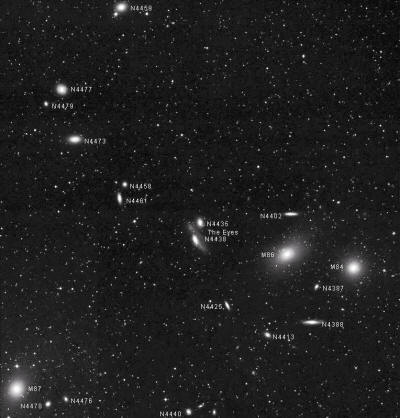|
AlienMind
The Verdants
5. - How Aliens View Us
If you get nothing else out of this book, please, remember the
following.
To extraterrestrials, who comprise the vast majority of intelligent
life in this universe, you are an alien. Humans are but one kind in
a huge catalogue of others. Some alien populations may have compiled
catalogues of millions of intelligent species, conceivably more. If
and when aliens begin (or began) to
electronically/electrogravitically copy other aliens’ catalogues of
the sort, the number of entries could increase exponentially.
Depending on the nature of the overlap between galaxies, there could
easily be catalogues of trillions of species, or more. In more
advanced circles, there could be a shared kind of Universal Report,
a complex news briefing that spans incredible distances and puts our
national broadcasts to shame. Rather than dwell upon the affairs of
one’s own small planet, such aliens could check on the science and
doings of other systems, ranging freely and diversely.
Aliens have specifically stated that faster-than-light
communications are a given among more advanced societies. Nearly
instantaneous capacities may be possible, as one native group of
Milky Way aliens reported, once electrogravity towers have been
installed and correlated to form a widespread network. Towers use
the iron core of a planet as a capacitor, which stores up and
releases charge (or electrogravity) without need for wires. There
may also be non-tower alternatives. *Thus far, no aliens have
reported the ability to “physically” travel great distances, i.e.
hundreds of light years, instantaneously.
The fastest published
report on the subject was logged by Los Angeles Times journalist
Phillip Krapf, who says that the Verdants, a group of
aliens with
whom he has interacted, can travel at a rate that is one million
times the speed of light, using what they call “flicker drive” (a
kind of electrogravity, apparently). Readers may be encouraged to
note that the aliens Krapf describes say that they’re only 229
million years more advanced, technologically, than are humans.
Older, more advanced alien populations may be much more capable.
Although, for fairly obvious reasons, most of the aliens reportedly
catalogued by human authorities stand upright and walk on two feet,
some look very different than a human. Brain appears to have
triumphed over brawn—in every case. Cranial capacity has been
expanded and body mass reduced, for ecological reasons. So,
generally speaking, technologically advanced aliens will likely have
large heads and relatively efficient bodies. Such appearances, along
with different skin colors and body heights can be startling to a
human, at least initially.
On larger planets with heavy gravity,
stocky bodies may endure, i.e. Stefan Denaerde’s remarkable report
about
Iarga—just 10 light years from Earth.
It helps to remember that we probably look as weird to them as they
do to us---with one minor exception. When they visit here, they
clearly know that our kind exists. They’ve studied humans and human
history. We’re an open book, as far as they’re concerned. Most of
our data, all of our books going to press and all of our electronic
communications can be lifted, using electrogravity, and recorded.
Think in terms of
Moore’s law (new computers double their capacity
every 18-24 months).
By now, aliens are able to store the sum total
of human electronic data, then file and correlate it compactly.
As other authors have suggested, we should be careful not to
generalize about all aliens.
There is great diversity among
off-world life forms. Some may be notably more advanced than others,
yet humans (and aliens) must forever be studied and vigilant in
their assessment of any given world, or combination of worlds.
Aliens, too, can make mistakes.
As one might expect, time and time again, aliens have proven
vulnerable to psychological error. They make very human-seeming
errors. Some humans will be disappointed to learn about certain
off-world regimes that control their populations through fear and
other, more subtle kinds of intimidation. In some cases, rather than
being corrected over time, specious impulses have been cultivated,
if not institutionalized within a limited number of overgrown alien
populations—one of which (Verdants—from another galaxy) literally
describes itself as “colonizers.”
However, in each case of the sort,
finer-minded independent civilizations grow up in surrounding
systems and offer a critique of such offenders. Clearly, humans can
choose to emulate a better strategy.
It helps to remember that, in some multi-galactic neighborhoods,
there may be a kind of bully, a population that’s both feared and
organized against—due to the given population’s excesses. Some
populations of the sort may have developed in relative isolation or
amid a heated galactic competition, a competition that, in the
bully’s case, results in a repressive bureaucracy—for defensive
reasons.
Sadly to say, some such bureaucracies have reportedly
lingered, long after the perceived external threat abated. According
to various aliens’ reports, the end result can be a subtly disguised
bias against other species, a presumption of superiority; an epic
kind of wastefulness.
What begins as a defensive mobilization ends
up as a self-serving apparatus intended to boost the given
population’s lifestyle above and beyond that of all local
competitors.
Sound familiar?
This puts the burden of correction on the surrounding populations,
who, in turn, must waste precious resources in a concerted attempt
to either ward off, or correct the burgeoning offender.
Ultimately,
inter-galactic agreements must arise in order to do so, i.e. on a galaxy supercluster level (thousands of galaxies). Even then, there
can be obstacles: hyper-advanced regimes on a larger scale that can
tend toward repression of individual sensitivities and seek to
control populations of lesser duration. Among the more aged aliens
in such regimes’ security services (some of whom can be thousands of
years old, if not more, hence extremely de-sensitized) the need to
control others can be destructive and rigidly compulsive in
character.
We need to be careful with regimes that tend to run on
autopilot due to advanced, albeit subtly-mechanized idealizations of
thought. Sometimes, due to age and mind-numbing experiences, they
seem to run out of creative impulses and lapse into defensiveness,
coupled with reflexive observation.
Based upon what we now know, we can expect to see neighborhoods
that, at times, are stressed in ways that literally tax the human
imagination. For example, the Milky Way lies just along the outer
fringe of the
Virgo supercluster of galaxies.
Virgo contains about
2000 galaxies, compared to the 3 spiral galaxies (plus 14 smaller
irregulars and 17 yet smaller ellipticals) in
the Milky Way’s local
group of galaxies.
Smack in the middle of the Virgo supercluster
(not a large supercluster—as superclusters go) is the galaxy M-87
(click below image), a
giant elliptical galaxy containing about 1.3 trillion suns’ worth of
mass. The Milky Way is less than one-fifth as big, in comparison.
Over time, M-87 has apparently gobbled up smaller galaxies, causing
a bizarrely destructive “hyper-nova” explosion whenever M-87’s
massive central black hole swallowed a smaller galaxy’s central
black hole.

So, in the center of Virgo is a giant galaxy (M-87) that is both too
hot, and too dangerous to support all of the populations of the
galaxies that M-87 ate, so to speak.
Surrounding galaxies would be
expected to accommodate a number of refugees, to share the burden
more widely.
Also within Virgo, i.e. running along what is called
the
Markarian Chain of galaxies (click
below image) are numerous other large ellipticals that would, by now, have required a similar cooperation.
As a result, we can reasonably predict that galaxy superclusters are:
-
either intense war zones, which would be both undesirable and
ecologically unsustainable (hence considerably less likely over
time),
-
or we can predict that they begin to organize into a greater
kind of commonality, which, although stressed at times, more
accurately reflects the larger universal ecology for one obvious
reason: most of the galaxies in our universe are found in galaxy superclusters.

Alien sources say that large-scale cooperation is the norm and that superclusters are carefully monitored as to ecological outcomes.
Given the prohibitive energy and environmental costs of war
involving advanced alien technologies, full-scale conflict is
reportedly rare. However, disputes can arise, which presumably
deepens the movement toward larger, collective alternatives and
legal arrangements.
In the end, the social prism through which humans view themselves
will affect
the way that humans both judge, and prepare to interact with
off-world populations.
But what about the more capable alien judgment of humans, in
return? If humans try to weaponize interstellar space in order leap
out and grab the planets of neighboring star systems, humans can
expect to either suffer their own internal contradictions, or
possibly perish prematurely due to elite-driven environmental
failures, some of which could involve the misuse of electrogravity.
In such a scenario, aliens would be less likely to advise on how to
use electrogravity correctly.
Further dangers lie in the submergence of a
US black budget regime
from public view. By pretending that it can play both good cop (by
interacting with aliens in an exclusively military-industrial
fashion), and, at the same time, play bad cop (by casually shooting
down numerous alien craft in order to scavenge them), it could
endanger our survival as a planet.
When a relatively backward human
structure of the sort gets its hands on technology that alien
neighbors cannot trust will be used safely, a basic judgment is in
order:
Should the planet be gently revolutionized, or should it be
“allowed” to perish—before it becomes too dangerous?
In later pages,
the topic will be discussed in specific detail, including direct
quotes by various aliens.
The main point to be conveyed at this juncture is that aliens are
fallible; they make mistakes.
The fact will be denied by those who
insist that every interaction with off-world visitors is a spiritual
awakening, a cosmic kind of homecoming. I’ve argued with otherwise
intelligent adults who insist that those seemingly good “gray”
aliens don’t do harmful abductions, they don’t collude with black
budget elements in the USA, they aren’t part of an attempt to play
both sides of the human fence off of each other for their
federation’s political and resource purposes.
I’ve debated one
well-educated researcher (R.B. -
Richard Boylan?) who, despite noting missing time
after which he found nasal implants and newly formed scoop marks in
his flesh (the result of an abduction), insists that gray-related
“federation” aliens have nothing to do with “harmful” abductions and
cattle mutilations.
* He also said that because such aliens
manipulated our genes, they “own” us, in part, and have a right to
manipulate us.
Meanwhile, a growing number of qualified researchers, including the
late Dr.
John Mack, professor of psychiatry at Harvard University,
concluded that such aliens appear to be engaged in some sort of
breeding program, an attempt to develop human-alien hybrids for
yet-unspecified reasons.
* The statements above aren’t intended to
demonize grays. Personally,
I feel sympathy for them. The loss of their original home planet may
have occurred under circumstances that offer humans a vital lesson
in off-world political ecology.
|

